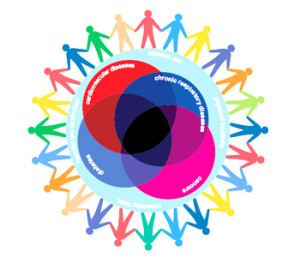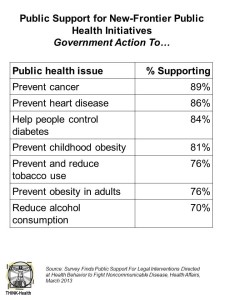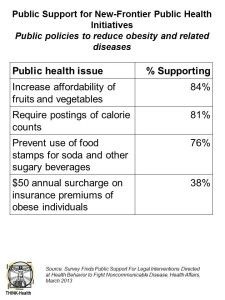 Most people like government policies targeting reducing tobacco use, requiring food manufacturers and restaurants to reduce salt content, and mandating schools to require 45 minutes of daily activity for students. A large majority of Americans (at least 8 in 10 people) support government actions to promote public health that stem chronic disease, from preventing cancer (89%) and heart disease (86%) to helping people control their diabetes (84%) and preventing childhood obesity (81%).
Most people like government policies targeting reducing tobacco use, requiring food manufacturers and restaurants to reduce salt content, and mandating schools to require 45 minutes of daily activity for students. A large majority of Americans (at least 8 in 10 people) support government actions to promote public health that stem chronic disease, from preventing cancer (89%) and heart disease (86%) to helping people control their diabetes (84%) and preventing childhood obesity (81%).
A Survey Finds Public Support For Legal Interventions Directed At Health Behavior To Fight Noncommunicable Disease (NCD). This poll, published in the March 2013 issue of Health Affairs, profiles the United States citizenry as public-health supportive — not nearly as “anti-Nanny State” as many mass media outlets and radio talk-show hosts represent.
 While a New York State Court knocked down Mayor Michael Bloomberg’s ban on jumbo-sized soda pop for New York City residents, it appears that most people, based on this survey by policy analysts at the Harvard University, think public posting of calorie counts, providing people with free nicotine patches, and making fruits and veggies more affordable are good tactics for government to implement to address the growth of NCDs. NCDs are the conditions that are amenable to lifestyle changes, especially in four areas:
While a New York State Court knocked down Mayor Michael Bloomberg’s ban on jumbo-sized soda pop for New York City residents, it appears that most people, based on this survey by policy analysts at the Harvard University, think public posting of calorie counts, providing people with free nicotine patches, and making fruits and veggies more affordable are good tactics for government to implement to address the growth of NCDs. NCDs are the conditions that are amenable to lifestyle changes, especially in four areas:
- Eating healthfully and in moderate portions,
- Engaging in regular physical activity,
- Quitting smoking, and
- Drinking alcohol in moderation.
 Underneath these big numbers are differences based on race, ethnicity, gender and age. African-Americans, women and people 19-35 are more supportive of public policies targeting public health than are whites, men and older Americans. Hispanics are also more supportive than whites in the areas of diabetes control and heart disease.
Underneath these big numbers are differences based on race, ethnicity, gender and age. African-Americans, women and people 19-35 are more supportive of public policies targeting public health than are whites, men and older Americans. Hispanics are also more supportive than whites in the areas of diabetes control and heart disease.
Interestingly, New York City residents were not more likely than people living elsewhere to support the public health initiatives even though they might have been more familiar with them.
On the other hand, people with diabetes were more likely to support public sector action in public health.
Health Populi’s Hot Points: The survey found that “the least coercive path is the smoothest.” That is, people are more supportive of government policies that allow them to make healthful choices; menu labels such as those mandated in NYC and subsidized access to nicotine patches for smoking cessation are examples of these tactics.
Policy making for public health interventions that seek to nudge people toward healthier behaviors, the authors say, would do well to pay attention to the public’s desire to be represented in policy making. This means getting Americans involved in public health priority-setting and policy discussions. “The challenge is to respond to (public) demand for a public health response to noncommunicable disease in ways that allow members of the public to feel that their voices are heart, understood, and valued.”
This is part of a larger concept of health equity and shared decision making. The latter is generally seen as a micro-relationship between patient/consumer and health provider/doctor. However, this survey points to a larger, macro-relationship between the health citizen and the government’s public policy makers. National associations such as the AARP, Consumers Union, labor unions, health advocacy organizations, and the like are often involved in inside-Beltway testimonies.
Outside of the Beltway, social media effectively network patients, consumers and caregivers, giving them a collective voice that these national associations might miss, especially in representing the values of various consumer segments. Policies that address NCDs, where lifestyle behaviors make huge differences, need to incorporate the patient/consumer voice, literally, into the mix. Communities such as PatientsLikeMe and WEGO Health are but two of many examples where large numbers of health consumers come together that can add voice and nuance to constructive policy making discussions.




 Interviewed live on BNN Bloomberg (Canada) on the market for GLP-1 drugs for weight loss and their impact on both the health care system and consumer goods and services -- notably, food, nutrition, retail health, gyms, and other sectors.
Interviewed live on BNN Bloomberg (Canada) on the market for GLP-1 drugs for weight loss and their impact on both the health care system and consumer goods and services -- notably, food, nutrition, retail health, gyms, and other sectors. Thank you, Feedspot, for
Thank you, Feedspot, for  As you may know, I have been splitting work- and living-time between the U.S. and the E.U., most recently living in and working from Brussels. In the month of September 2024, I'll be splitting time between London and other parts of the U.K., and Italy where I'll be working with clients on consumer health, self-care and home care focused on food-as-medicine, digital health, business and scenario planning for the future...
As you may know, I have been splitting work- and living-time between the U.S. and the E.U., most recently living in and working from Brussels. In the month of September 2024, I'll be splitting time between London and other parts of the U.K., and Italy where I'll be working with clients on consumer health, self-care and home care focused on food-as-medicine, digital health, business and scenario planning for the future...